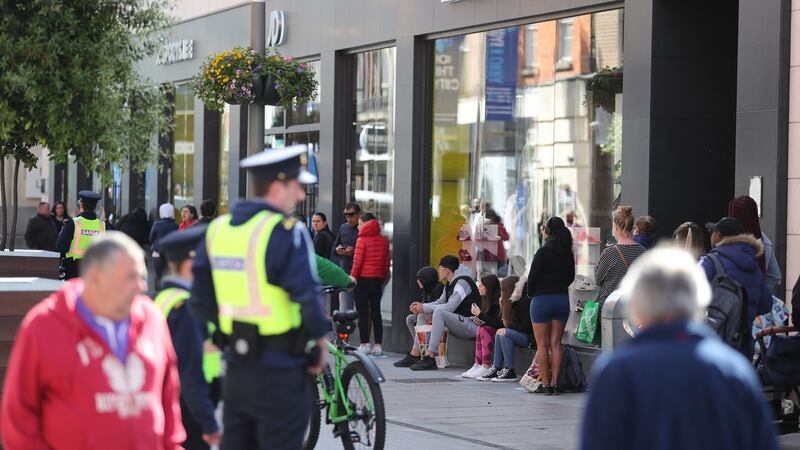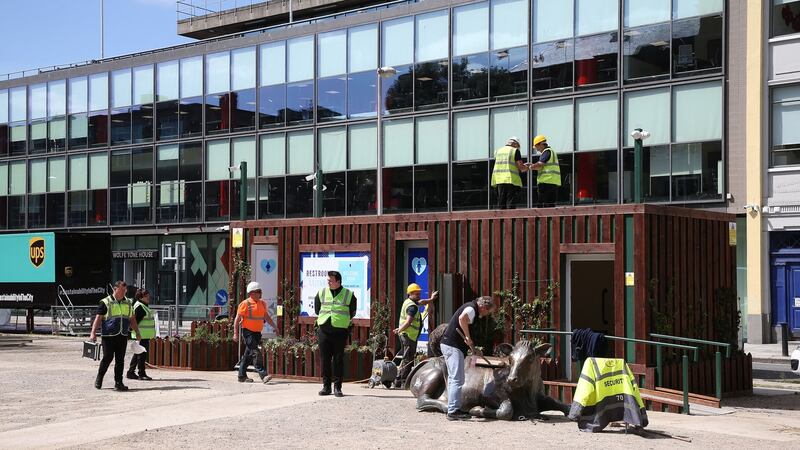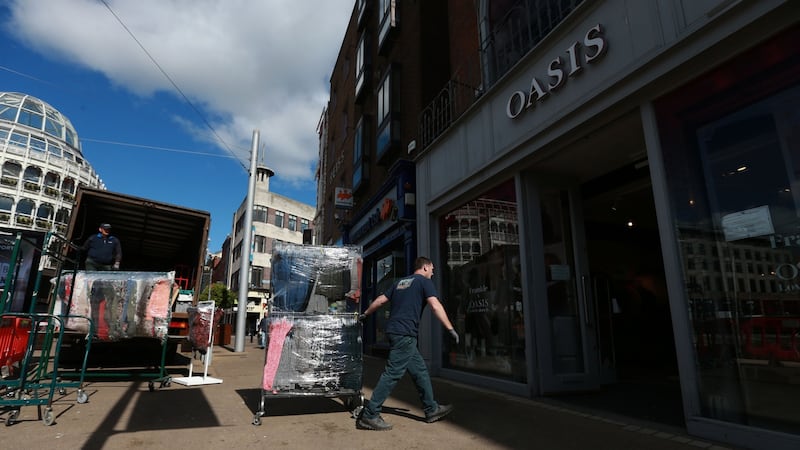“Goodbye Slippers. Hello Sneakers” reads the sign outside the Foot Locker shops in Dublin city centre this week. Since Monday, shops deemed non-essential during the pandemic have been cautiously reopening – to a transformed world and a entirely new set of operating challenges.
It’s business, but not as usual.
For a start, the new opening time is 10.30am. Teams of gardaí are patrolling the streets to ensure customers queueing outside shops maintain social distancing. They are doing this politely, but it is not a normal customer experience to have law enforcement representatives in such close, visible and constant proximity.
There are noticeable crowd barriers on street corners, so streets can be closed off quickly if shopper numbers cause social-distancing problems. Applying hand-sanitiser on entry into shops is mandatory.
Shoppers have become used to queueing and hand-sanitising while visiting supermarkets over the past several weeks. But shopping for non-essential items, a formerly leisure activity, is a very different experience from buying foodstuffs. Buying clothing or footwear or bags or items like cameras, books and pens is something people choose to do.
The challenge retailers face now is balancing public health safety with the need to keep their shops enticing places to visit in person. Otherwise, many people will migrate for the foreseeable future to online shopping.
Weir’s, Grafton Street
At Weir’s on Grafton Street, I am asked to put on a face mask (it is provided) on entry to the shop. The maximum number of customers is 20, and they are encouraging visits by appointment.
“We are meeting customers at the door, and asking what they are looking for,” explains managing director David McCormick. He is wearing a face shield. The shop has five departments, so they then direct customers to their specific area of interest. It’s efficient, but completely removes the browsing experience.
It’s clear that expensive jewellery of the kind Weir’s sells must be tried on before purchase. “We steam clean afterwards on the premises,” he says. “Watches that have leather straps are put aside for 72 hours.”
Weir’s is getting some business, but there are no tourists, on whom a percentage of its trade relies. Tourists are a passing trade and do not shop via pre-booked appointments, and as they don’t know the shop, they like to browse. “That is going to be a different experience and challenge for us,” McCormick says.

Oasis, Stephen’s Green
I join a short queue at Oasis, the clothing store at Stephen’s Green. It’s a one-in, one-out policy. There’s a large sign up outside the closed changing rooms. “Customers are requested not to try on any stock. This is to ensure high standards of hygiene are maintained.”
A woman near me asks a shop assistant if she can try on garments over her clothes. Yes, is the answer. People start pulling on dresses and jackets and jumpers over their own clothes, and looking in the long mirrors throughout the shop. They also try on footwear.
I try on a dress myself, but find it impossible to gauge a fit over the dress I am already wearing. I look for a return rail to hang this dress on, but of course, there is no return rail, as the changing rooms are shut.
I watch what other customers do. They return the garments to the rails where they took them from. I do the same. Staff don’t comment.
Thomas Patrick, Grafton Street
“People are not browsing,” says Orna Fitzpatrick, co-director of Thomas Patrick’s shoe shop with her sister Eilis. “They are coming in on a mission. Shoppers are more decisive than they used to be.” Their shop is currently only admitting four customers at a time. They have imported a special shoe sanitiser, which is sprayed into, and on to, all footwear tried on but not purchased.
Basecamp, Jervis Street
At Basecamp Outdoor Store on Jervis Street, about half the stock is waterproof jackets, fleeces and hiking boots. Floor manager James Lucas explains that customers must take home clothes to try them on. If they don’t fit, they are then taken off the floor for 72 hours.
Customers can try on boots. Boots tried on, but not purchased, are taken off the floor for 72 hours. While I am there, a customer is already trying on his fourth pair of hiking boots. It doesn’t take much ability at maths to realise this is not a long-term sustainable business model, if large quantities of stock have to be quarantined for days at a time.

Siopaella, Wicklow Street
At Siopaella on Wicklow Street, a designer resale shop for clothing and bags, I ring for entry. I’m asked if I have an appointment. I don’t. Do I have a mask, I’m then asked, as I need one to enter the shop. I do have a mask in my bag, but say no, to see what will happen. The assistant provides me with a mask, and I look around.
There is no trying on of clothes, and given that these are all individual pre-worn pieces, many of them expensive, I give up almost immediately. I have no interest in buying an expensive items to try on at home, in the hope it might fit, knowing that if it doesn’t, I have to make a second trip to town to do the return.
I can’t help wondering what is the difference between trying on something in the shop, and trying on the same garment at home and bringing it back. After all, when you buy an item of clothing online, you have a choice to return it, as long as the tags are still on it, and it’s evident you have just tried it on, as opposed to wearing it.
Pen Corner, College Green
At the Pen Corner on College Green, owner John Fitzgerald is full of questions about what items customers can and can’t touch. “The default setting for everyone should be: where is the science?” he says. “And nobody can tell us. And everything is changing all the time.”
At present, he is having to email the manufacturers of his high-end fountain pens to inquire if he can use alcohol wipes on them without damaging the pen barrel surfaces. Some nibs are gold. “Is gold germ-free?”
At present, only three customers at a time can enter his galley-shaped shop. Pens that customers have handled and not bought, are taken out of stock for a period.
He is using only previously unboxed products. “But that is totally unsustainable for longer than a period of weeks,” he says.

Arnotts, Henry Street
At Arnotts on the morning it opens (Wednesday), I queue for less than three minutes before being allowed in. In general, queues around town are short, and the shops that do have queues are almost all selling sportswear, runners and footwear in general, such as JD Sports, Foot Locker, Office and Skechers.
In Arnotts, the policy for trying on clothes is three garments at any one time. An assistant tells me clothes not purchased will be steamed at 60 degrees before being put back out again.
There are signs throughout the shop explaining their returns policy. “Strictly no items deemed to have been worn will be returned unless there is a fault in the item. All returned goods will be kept in a quarantined location for a minimum of 24 hours. All items are steamed and sanitised prior to returning to the shop floor.”
There are more signs asking customers to keep touching to a minimum. As I wander through the women’s wear floor, I find it difficult not to automatically reach out to test the texture of a fabric, or to pull out a garment to see it properly.
Salespeople hover nearby anxiously, watching. I’m not asked to stop touching things, but I become so conscious of it, I stop. And because I can’t see anything properly without touching it, I don’t try anything on. Nobody really seems to know how to behave when it comes to touching clothing.
Meanwhile, other shoppers – in common with shoppers in every other shop I go into – are sometimes observing social distancing, but mostly not. It all begins to feel a bit stressful.
The Gutter Bookshop, Cow’s Lane
At the Gutter Bookshop on Cow’s Lane, owner Bob Johnston has temporarily removed the three armchairs that used to be on the shopfloor. This is to both make more space on the shop floor, and to discourage people from staying too long. He can admit eight people at a time.
“Nobody has robbed our hand-sanitiser from beside the door yet. I was expecting to lose it on the first hour of opening,” he says laconically.
“I decided not to make a big thing about not touching the books,” he says. “It’s almost business as normal.” There are no signs asking people not to browse or to keep their visit short, although he hopes people won’t spend longer than 15 minutes in the shop. Books brought to the counter but not bought are “put away for a while” before being returned to shelves.

Enable Ireland, South Great George Street
At the Vincent de Paul charity shop on South Great George Street, there’s a sign in the window saying “all donated clothing quarantined for 72 hours.” Nearby at Enable Ireland, changing rooms are closed.
In Enable Ireland, I ask what their trying-on policy is. The assistant tells me items have to be taken home to be tried on, and can be brought back within 48 hours for refund. Then she says, “You can try on some things quickly. Like jackets and shoes.”
I watch a customer try on platform sandals in her bare feet, and then a pair of stilettos. She puts them back on the floor afterwards, and there they remain. She doesn’t buy either pair.
And – at least while I am in the shop – there is no sign of these shoes being removed to be put into quarantine.
It becomes clear to me over the period of time I spend browsing in the shops that everybody is trying to figure out how best to navigate their way through these unprecedented times for retail, especially when it comes to touching and trying on clothing.
Without exception, staff in every shop I visit are extremely welcoming, clearly delighted to see customers again, and anxious to help.
But there is no common approach, apart from the default hand-sanitisers at the entrance to every shop. Very few shoppers are wearing masks, and the policy on mask-wearing by employees on the staff floor varies from shop to shop. Some are wearing masks, and others aren’t, even within departments in the same shop. It’s a mixed message.
The Camera Centre, Grafton Street
At the Camera Centre on Grafton Street, manager Damien Byrne explains that all cameras have to be wiped down after handling. They are trying to discourage people from handling cameras, but customers understandably want to gauge weight and the zoom facilities of a lens.
“People come to us for advice,” he says. “We’re a specialised service. They tend to do their research online and then come in to ask questions when they know what they’re looking for.”
Byrne says they are managing for now, restricting the number of customers in the shop. “But if this goes on for much longer, what happens?” he asks. “At the moment there are no tourists, but what happens then? Or at Christmas, when there are usually 10-15 customers in the shop at any one time?”

Brown Thomas, Grafton Street
Brown Thomas also opened on Wednesday. There are separate short queues to access the Louis Vuitton and Hermes outlets, but I do not have to queue at all to go in by the main entrance. “In the interest of safety, please think before you touch,” read the signs positioned all over the shop.
Downstairs, the designer bags which usually have their very steep price tags tucked away unseen within the bag, all have their prices clearly visible, presumably to take away the need for customers to go rummaging inside to look for the tag.
When it comes to clothing, the policy is that shoppers can try on anything they like. Items not purchased are then steamed and returned after a period of quarantine.
I dither over a couple of different styles on sale at a label I buy something from once a year, and the assistant brings six dresses to the changing room for me to try. It almost feels normal, bar the fact I feel compelled to tell her which two dresses of the six I have not tried on after I make my choice of one, so that those two garments do not have to go into the steaming-quarantine cycle.
Finding a bathroom
Scattered throughout the city at present are people in blue jackets, who are volunteering for Dublin City Centre, acting as mobile information points as the city gets back to business. Patricia Mullane on Grafton Street is one of them. What is it that people are asking her?
“Where is there a toilet they can use,” she says. “That’s what everyone wants to know. And there are not many places. There is only City Hall, St Patrick’s Park, and the two new Dublin City Council blocks on Grafton Street and at Wolf Tone Square.” Shoppers have also been asking Mullane where there are baby-changing facilities.
“Dublin City Council didn’t think of that,” she says, adding that there are plans to provide these facilities later in the week, possibly by doubling up on the use of the designated disabled toilet space in each of the council’s two new blocks.
With the temporary closure of toilets in department stores, and the closure of restaurants, it has again been made clear how lacking Dublin city centre is in public toilet facilities.
I join a short queue on Grafton Street to use the facilities there; access to which is controlled by a rota of people from Dublin City Council
Open from 10am to 8pm, the brand-new toilets are spotlessly clean, and are being constantly cleaned. There are many things the general public will be glad never to see again when this peculiar era is all over, such as tape marking the two-metre distance outside shops, but these new public toilets are a definite welcome amenity to the city, and hopefully will remain.






















